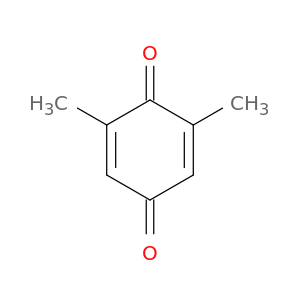
2,6-Dimethylbenzoquinone
| Title | Journal |
|---|---|
| Towards a systematic analysis of human short-chain dehydrogenases/reductases (SDR): Ligand identification and structure-activity relationships. | Chemico-biological interactions 20150605 |
| The pea SAD short-chain dehydrogenase/reductase: quinone reduction, tissue distribution, and heterologous expression. | Plant physiology 20110401 |
| Role of quinones in the ascorbate reduction rates of S-nitrosoglutathione. | Free radical biology & medicine 20101115 |
| Photolabile ubiquinone analogues for identification and characterization of quinone binding sites in proteins. | Bioorganic & medicinal chemistry 20100515 |
| Chemical oxidation of 2,6-dimethylaniline by electrochemically generated Fenton's reagent. | Journal of hazardous materials 20100415 |
| Kinetics and mechanism of 2,6-dimethyl-aniline degradation by hydroxyl radicals. | Journal of hazardous materials 20091230 |
| Chemical oxidation of 2,6-dimethylaniline in the fenton process. | Environmental science & technology 20091115 |
| Quinone-enhanced reduction of nitric oxide by xanthine/xanthine oxidase. | Chemical research in toxicology 20090501 |
| Flavodiiron proteins in oxygenic photosynthetic organisms: photoprotection of photosystem II by Flv2 and Flv4 in Synechocystis sp. PCC 6803. | PloS one 20090101 |
| Redox characteristics of a de novo quinone protein. | The journal of physical chemistry. B 20070405 |
| Synthesis of the tetracyclic core of the kempanes by a ring-closing metathesis strategy. | Organic letters 20060105 |
| Synthetic studies toward the kempane diterpenes. Construction of a key tricyclic intermediate. | Organic & biomolecular chemistry 20051007 |
| 2,6-dimethyl-1,4-benzoquinone 4-monooxime. | Acta crystallographica. Section C, Crystal structure communications 20050401 |
| Characterization of a new member of the flavoprotein disulfide reductase family of enzymes from Mycobacterium tuberculosis. | The Journal of biological chemistry 20041210 |
| 1-Chloro-3,6-dimethoxy-2,5-dimethylbenzene and 1-chloro-3,6-dimethoxy-2,4-dimethylbenzene. | Acta crystallographica. Section C, Crystal structure communications 20040701 |
| Efficient methods for the preparation of alkyl-aryl and symmetrical or unsymmetrical dialkyl ethers between alcohols and phenols or two alcohols by oxidation-reduction condensation. | Journal of the American Chemical Society 20040616 |
| A convenient method for the preparation of inverted tert-alkyl carboxylates from chiral tert-alcohols by a new type of oxidation-reduction condensation using 2,6-dimethyl-1,4-benzoquinone. | Journal of the American Chemical Society 20030903 |
| Catalysis of diaphorase reactions by Mycobacterium tuberculosis lipoamide dehydrogenase occurs at the EH4 level. | Biochemistry 20030225 |
| Targeted disruption of psbX and biochemical characterization of photosystem II complex in the thermophilic cyanobacterium Synechococcus elongatus. | Plant & cell physiology 20010201 |